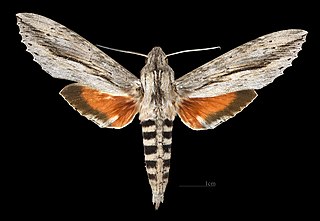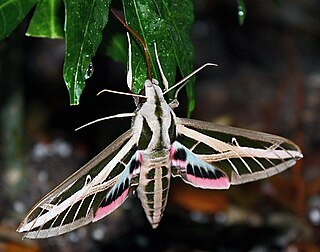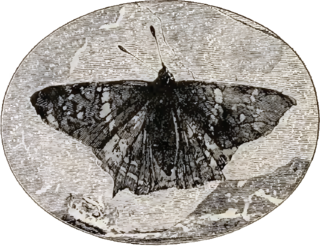
Incertae sedis or problematica is a term used for a taxonomic group where its broader relationships are unknown or undefined. Alternatively, such groups are frequently referred to as "enigmatic taxa". In the system of open nomenclature, uncertainty at specific taxonomic levels is indicated by incertae familiae, incerti subordinis, incerti ordinis and similar terms.

Eumorpha labruscae, the gaudy sphinx, is a moth in the family Sphingidae.

Erinnyis ello, the ello sphinx, is a moth of the family Sphingidae. The species was first described by Carl Linnaeus in his 1758 10th edition of Systema Naturae. It is distributed from Argentina through Central America to the United States as far north as Nevada.

Gracillariidae is an important family of insects in the order Lepidoptera and the principal family of leaf miners that includes several economic, horticultural or recently invasive pest species such as the horse-chestnut leaf miner, Cameraria ohridella.
Agathiphaga is a genus of moths, known as kauri moths. and is the only living genus in the family Agathiphagidae. This caddisfly-like lineage of primitive moths was first reported by Lionel Jack Dumbleton in 1952, as a new genus of Micropterigidae.

Lithodryas is a prehistoric genus of butterflies in the family Lycaenidae. It was introduced as a replacement for Samuel Hubbard Scudder's genus Lithopsyche, which is invalid as a homonym, as another fossil lepidopteran genus had been described under the same name shortly before Scudder established his genus.
Noctuites is a genus of extinct moths in the Noctuoidea superfamily. This genus was originally designated to accommodate noctuids of uncertain association. Most noctuoid fossils are incomplete, making them hard to place in a modern phylogeny of Noctuoidea. For this reason the genus has not been assigned to a family.
Geometridites is an extinct genus of moths in the family Geometridae. The genus was erected by Clark et al. in 1971.

Pseudoclanis is a genus of moths in the family Sphingidae erected by Walter Rothschild in 1894. They are found in sub-Saharan Africa and the southern part of the Arabian Peninsula.

Polyptychopsis is a genus of moths in the family Sphingidae. It contains only one species, Polyptychopsis marshalli, which is known from Brachystegia woodland in large parts of Africa.
Stigmellites is a genus of Lepidopteran fossils. It is only known from trace fossils of leaf mines.

Pseudobornia is a genus of plants known only from fossils found from the Upper Devonian. It contains a single species Pseudobornia ursina, and is the earliest fossil assigned with certainty to the Equisetopsida.

Polyptychus andosa, or Coryndon's polyptychus, is a moth of the family Sphingidae. It is known from eastern and western Africa.

Lintneria is a genus of moths in the family Sphingidae, containing the following species:

Temnora pylas is a moth of the family Sphingidae. It is known from South Africa and Zimbabwe.

Eumorpha fasciatus, the banded sphinx, is a moth of the family Sphingidae. The species was first described by Johann Heinrich Sulzer in 1776.

The Lepidoptera fossil record encompasses all butterflies and moths that lived before recorded history. The fossil record for Lepidoptera is lacking in comparison to other winged species, and tending not to be as common as some other insects in the habitats that are most conducive to fossilization, such as lakes and ponds, and their juvenile stage has only the head capsule as a hard part that might be preserved. Yet there are fossils, some preserved in amber and some in very fine sediments. Leaf mines are also seen in fossil leaves, although the interpretation of them is tricky. Putative fossil stem group representatives of Amphiesmenoptera are known from the Triassic.
Eocoronidae is an extinct family of insects from the Carnian age of the Triassic period. It was established in 1981 by the Australian entomologist Norman Tindale. At present, it contains only one species and genus: Eocorona iani.
Gallerites is an extinct genus of snout moths. It was described by Kernbach in 1967, and contains the species Gallerites keleri which is known from the Pliocene. The species was discovered in Willershausen in Germany.
Ngapakaldia is an extinct genus of diprotodontid marsupials, related to the modern koala and wombat. Around the size of a sheep, it was a ground-dwelling herbivore that lived around the vegetated shores of lakes in Central Australia during the Late Oligocene.









